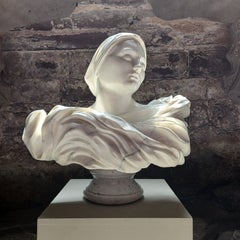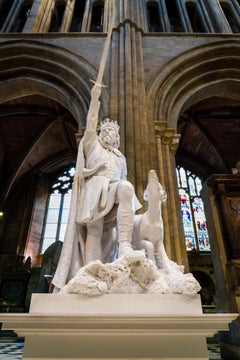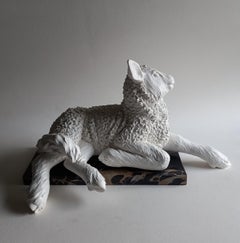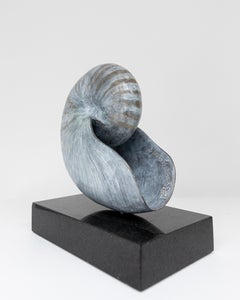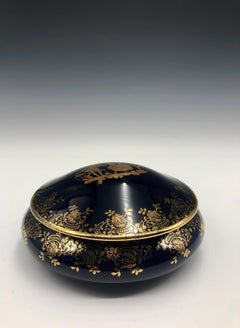Barry Davies
British, b. 1962
Intrinsically artistic and previously trained as a precision engineer Barry Davies started up a small business in 1989 as a cabinet maker. He introduced carving to embellish the furniture which proved popular with clients. The carving rapidly developed to sculpture and realising the need to extend his knowledge of the traditions of sculpture, Davies studied Art History with the Open University. He developed the use of the golden ratio to proportion his works as did renaissance sculptors Donatello and Michelangelo. He has sculpted portrait busts of Julius Caesar, Shakespeare and many others from solid Cararra marble blocks imported from Italy. He also sculpted a statue of 16th century Bishop William Morgan who translated the Bible from Hebrew into Welsh. Davies' passion for anthropology, palaeontology and anatomical study has led him to not only create bronze sculptures but also tutoring classes in clay modelling of these subjects. Since 2010 Davies has exhibited his sculptures in the UK and Europe. The international exhibitions include venues in Chelsea, London,- Uffizi gallery, Florence, - Bramante Halls, Rome,- Flangini Palace, Venice - Milan - Verona and Barcelona. Davies now creates 3/4 life-size statues of historical figures namely St.david, Llywelyn ap Iorwerth (Llywelyn the Great) ,a thoroughbred horse and the Coronation of Henry V. He was a member of a panel of judges of the prestigious ‘Visual Art Open’ in Chester, UK. Davies' sculptures are the culmination of decades of study of human and animal anatomy, classical, renaissance and Baroque sculpture creating his own unique style in figurative statuary and depicting natural history in bronze.(Biography provided by Barry Davies sculptor)
to
13
11
9
2
1
1
Borzois
Located in Oswestry, GB
Borzois or Russian wolfhounds originated in the 17th century and were bred and prized by the Russian aristocracy for their elegance and beauty. Davies has depicted this pair exhibiti...
Category
2010s Naturalistic Barry Davies
Materials
Granite, Bronze
Joan of Arc
Located in Oswestry, GB
Joan of Arc is depicted here at a solo exhibition in St. Edwards chapel at St. David's Cathedral, South Wales. Hand carved from a solid block of Carrara marble imported from Italy, Davies used traditional tools also used by the master sculptors of the renaissance. She is life size and expresses purity of soul as you see her in Divine contemplation. This portrait bust sits proportionately on a marble socle, the design of which is from the classical Ionic order.
Category
2010s Baroque Barry Davies
Materials
Marble
Llewelyn ab Iorwerth (Llewelyn the Great)
Located in Oswestry, GB
Llywelyn ab Iorwerth, (Llywelyn the Great) born in Dolwyddelan d.1240AD Aberconwy Abbey.
King of Gwynedd and Prince of Wales he dominated Wales for 45 years. In 1200 Llywelyn made a ...
Category
2010s Baroque Barry Davies
Materials
Bronze
Lamb
Located in Oswestry, GB
This lamb is also featured in my statue of Saint David. It conveys such character and gentleness that I decided to present it as a sculpture in its own right. I lays on a base of bla...
Category
2010s Baroque Barry Davies
Materials
Marble, Bronze
Perseus' Foot
Located in Oswestry, GB
In Greek mythology Perseus was the son of Zeus and Danae also founder of ,Mycenae. Davies' respect for classical sculpture is evident in this depiction of Perseus' foot and highly de...
Category
2010s Renaissance Barry Davies
Materials
Granite, Bronze
Nautilus
Located in Oswestry, GB
The Nautilus shell is an excellent example of mathematics inherent within lifeforms of the natural world. As Davies consistently uses the 'golden ratio' (1:1.618) to proportion his work, he thought it important to exemplify this in his subject matter. The Fibonacci sequence (where each number is the sum of the two preceding numbers) and the logarithmic spiral are also inherent here.
The bronze shell is mounted on a black granite base in a way that creates an optical illusion suggesting it is levitating above the base.
This bronze Nautilus...
Category
2010s Naturalistic Barry Davies
Materials
Granite, Bronze
Sinosaurusopteryx Prima
Located in Oswestry, GB
Sinosaurusopterx Prima
Category
15th Century and Earlier Naturalistic Barry Davies
Materials
Bronze
Saint David
Located in Oswestry, GB
This statue of Saint David, the Patron Saint of Wales stands 150cm high and is depicted with historical accuracy. Davies created this statue following extensive and thorough research...
Category
2010s Baroque Barry Davies
Materials
Bronze
Metta Buddha
Located in Oswestry, GB
This bronze statue is a Metta Buddha or Protective Buddha. The accuracy of the varying elements and characteristics of Davies' depiction has been thoroughly researched and well found...
Category
2010s Other Art Style Barry Davies
Materials
Bronze
Anatomical study of a lion
Located in Oswestry, GB
This artwork is described beautifully by Art critic and curator Salvatore Russo at an exhibition in Uffizi Gallery, Florence 2016 - "Barry Davies, a sculp...
Category
16th Century Northern Renaissance Barry Davies
Materials
Bronze
Equus Caballus (modern horse)
Located in Oswestry, GB
The evolutionary lineage of the horse is in palaeontological terms well documented. The natural history of the horse family Equidae began during the Eocene epoch 56 million to 33.9 million years ago starting with Eohippus (Dawn horse) evolving to Mesohippus , Merychippus, Pliohippus through to our modern...
Category
2010s Baroque Barry Davies
Materials
Granite, Bronze
Scottish Blackface Ram (Ovis Aries)
Located in Oswestry, GB
This portrait bust of a Scottish blackface ram that occupies an active use of space, is the ideal subject matter for a dynamic, bold yet serene bronze sculpture. The ram's magnificen...
Category
21st Century and Contemporary Naturalistic Barry Davies
Materials
Granite, Bronze
Anatomical Study of the Horse
Located in Oswestry, GB
Passionate about anatomy and the natural form, Davies modelled this hunter/thoroughbred type horse in a way that exhibits the inherent beauty of its skeletal shape and musculature, ...
Category
21st Century and Contemporary Northern Renaissance Barry Davies
Materials
Granite, Bronze
Related Items
French 19th century Animalier bronze of Two Hares on a naturalistic base
By Alfred Dubucand
Located in Bath, Somerset
19th century bronze group of a standing and sitting hare by French animalier sculptor Alfred Dubucand (1823-1894). Finely detailed bronze with good dark brown patination. Signature '...
Category
Late 19th Century Naturalistic Barry Davies
Materials
Bronze
Vintage Cobalt Blue and Gold Trim Limoges Porcelain Trinket Box France
Located in East Quogue, NY
Beautiful vintage cobalt blue lidded porcelain trinket jewelry box with gold hand-painted floral decorative rim. The central illustration is of a couple dressed in Louis XVI period s...
Category
Mid-20th Century Baroque Barry Davies
Materials
Ceramic, Porcelain
Vintage Peacock I (Wall Piece/Dish) (MADE TO ORDER) (~50% OFF LIMITED TIME ONLY)
By Melanie Sherman
Located in Kansas City, MO
(MADE TO ORDER) (Hand-painted, hand-made, porcelain)
*Lead Time may vary between 1-3 weeks
Melanie Sherman
Vintage Peacock I (Wall Piece/Dish (handpainted)
Porcelain, Glaze, Overglaze, Chinapaints, 24k German Gold Luster, Brass Wire (for hanging, can be removed)
Year: 2022
Size: 4.5x6x0.5in
Signed by hand
COA provided
Ref.: 924802-1330
------------------------
My ceramics are handmade and painted with the finest overglazes from Europe. The gold luster used is 24k liquid Gold from Germany. Every piece is unique. My imagery is inspired by vintage Meissen dinnerware...
Category
2010s Baroque Barry Davies
Materials
Brass
A late 19th century bronze animalier figure of a seated hound
By Prince Paul Troubetzkoy
Located in Bath, Somerset
A late 19th century bronze of a hound, seated on a naturalistic base, after Prince Paul Troubetzkoy. Incised to base 'Paolo Troubetzkoy 1893', with a dark brown patina.
Born in 1866...
Category
Late 19th Century Naturalistic Barry Davies
Materials
Bronze
A 19th century bronze sculpture of an Irish Wolfhound dog
Located in Bath, Somerset
Arthur Waagen (German 1833-1898): A 19th century bronze of the Irish Wolfhound 'Gelert', the base set with a scroll giving the dimensions and weight of...
Category
19th Century Naturalistic Barry Davies
Materials
Bronze
Antique French Gilt Bronze Marble Statue Sculpture of Fortuna Louis G Fulconis
Located in Portland, OR
A very good large antique French gilt bronze of the Roman goddess Fortuna, by Louis Guillaume Fulconis (1818-1873), circa 1860.
The bronze is inspired by sculpture of the Italian Ren...
Category
1860s Renaissance Barry Davies
Materials
Bronze
Vintage Peacock III (Wall Piece/Dish (hand-painted, made to order by the artist)
By Melanie Sherman
Located in Kansas City, MO
Melanie Sherman
Vintage Peacock III (Wall Piece/Dish (handpainted)
Porcelain, Glaze, Overglaze, Chinapaints, 24k German Gold Luster, Brass Wire (for hanging, can be removed)
Year: 20...
Category
1790s Baroque Barry Davies
Materials
Brass
Roman 18th century terracotta model for the sculpture of San Camillo de Lellis
Located in London, GB
This remarkably fluid terracotta bozetto was made in preparation for Pietro Pacilli’s most important public commission, a large-scale marble statue of San Camillo de Lellis for the nave of St Peter’s Basilica in Rome. Expressively modelled, this terracotta sculpture is a rare and significant work made by a major Roman sculptor at a transformative moment of European sculpture. Pacilli began his working life on the great Baroque decorative projects initiated in the seventeenth century, but he found success as a restorer of ancient sculpture working to finish antiquities for a tourist market, becoming an important figure in the emergence of an archaeologically minded Neoclassicism. Pacilli trained Vincenzo Pacetti and provided important decorative work for the Museo Pio-Clementino, at the same time he is recorded restoring some of the most celebrated antiquities excavated and exported during the period.
Pacilli was born into a family of Roman craftsmen, his father Carlo was a wood carver, and Pacilli is recorded working with him on the Corsini Chapel in San Giovanni Laternao as early as 1735. In 1738 his terracotta model of Joseph and Potiphar’s Wife won the first prize in the second class of the sculpture concorso at the Accademia di San Luca, this is particularly notable as Bartolomeo Cavaceppi came third. He worked as a carver and stuccoist completing works for the churches of San Marco and SS. Trinita dei Domeniciani Spagnoli. Pacilli operated as a sculptor and restorer of antiquities from his studio at the top of the Spanish Steps, close to Santa Trinita dei Monti, where he is listed as a potential vendor to the Museo Pio-Clementino in 1770.
In 1763 Pacilli completed a silver figure of San Venanzio for the treasury of San Venanzio. He is recorded as Pacetti’s first master and it was evidently through Pacilli that he began to acquire his facility as a restorer of ancient sculpture. Pacilli, at his studio ‘poco prima dell’Arco della Regina alla Trinita dei Monti,’ exercised, what the nineteenth-century scholar, Adolf Michaelis called ‘rejuvenating arts’ on several important pieces of classical sculpture, including in 1760 the group of a Satyr with a Flute for the natural brother of George III, General Wallmoden, Hanovarian minister at Vienna. In 1765, Dallaway and Michaelis record that Pacilli was responsible for the restorations, including the addition of a new head, to the Barberini Venus which he had acquired from Gavin Hamilton. The Venus was then sold to Thomas Jenkins, who in turn passed it on to William Weddell at Newby Hall. In 1767 Pacilli exported a series of ancient busts ‘al naturale’ including portraits of Antinous, Julius Ceaser and Marus Aurelius, also a statue of a Muse and a Venus. As early as 1756 Pacilli seems to have been operating as an antiquarian, helping to disperse the collection of the Villa Borrioni. Pacilli supplied sculpture to notable British collectors, including Charles Townley, who on his first trip to Italy purchased the Palazzo Giustiniani statue of Hecate from Pacilli. Pacilli was involved with the Museo Pio Clementino from its conception, supplying busts of Julius Ceaser and a Roman Woman as well as completing stucco putti surmounting the arms of Pope Bendedict XIV to signal the entrance to the new Museo Critiano.
In 1750 Il Diario Ordinario del Chracas announced that Pacilli had begun work on a sculpture of San Camillo de Lellis for St Peter’s. Camillo de Lellis founded his congregation, the Camillians, with their distinctive red felt crosses stitched on black habits in 1591. Having served as a soldier in the Venetian army, Camillo de Lellis became a novitiate of the Capuchin friars, he moved to Rome and established a religious community for the purpose of caring for the sick. In 1586 Pope Sixtus V formerly recognised the Camillians and assigned them to the Church of Santa Maria Maddalena in Rome. Camillo de Lellis died in 1614 and was entombed at Santa Maria Maddalena, he was canonised by Benedict XIV on June 26, 1746. It was an occasion that prompted the Camillians to make a number of significant artistic commissions, including two canvases by Pierre Subleyras showing episodes from San Camillo’s life which they presented to Benedict XIV. In 1750 Pacilli was commissioned to fill one of the large niches on the north wall of the nave with a sculpture of San Camillo.
The present terracotta bozetto presumably had two important functions, to enable Pacilli to work out his ideas for the finished sculpture and at the same time to show his design to the various commissioning bodies. In this case it would have been Cardinal Alessandro Albani and Monsignor Giovan Francesco Olivieri, the ‘economo’ or treasurer of the fabric of St Peter’s. Previously unrecorded, this terracotta relates to a smaller, less finished model which has recently been identified as being Pacilli’s first idea for his statue of San Camillo. Preserved in Palazzo Venezia, in Rome, the terracotta shows San Camillo with his left hand clutching his vestments to his breast; the pose and action more deliberate and contained than the finished sculpture. In producing the present terracotta Pacilli has expanded and energised the figure. San Camillo is shown with his left hand extended, his head turned to the right, apparently in an attempt to look east down the nave of St Peter’s. The model shows Pacilli experimenting with San Camillo’s costume; prominently on his breast is the red cross of his order, whilst a sense of animation is injected into the figure through the billowing cloak which is pulled across the saint’s projecting right leg. The power of the restrained, axial contrapposto of bent right leg and outstretched left arm, is diminished in the final sculpture where a baroque fussiness is introduced to the drapery. What Pacilli’s terracotta demonstrates, is that he conceived the figure of San Camillo very much in line with the immediate tradition of depicting single figures in St Peter’s; the rhetorical gesture of dynamic saint, arm outstretched, book in hand, head pointed upwards was perhaps borrowed from Camillo Rusconi’s 1733 sculpture of St. Ignatius...
Category
18th Century Baroque Barry Davies
Materials
Terracotta
17th C Polychromed fruitwood carved statue depicting Madonna, France.
Located in brussel, BE
An exceptionally beautiful antique French wood carving, made in the 17th century. It depicts Madonna standing with open offering arms .The...
Category
17th Century Baroque Barry Davies
Materials
Wood
A lady. Contemporary bronze sculpture, Abstract & figurative, Polish art
By Stanisław Wysocki
Located in Warsaw, PL
Contemporary bronze sculpture on marble base by Polish artist Stan Wysocki. Artwork comes from limited edition of 8. Sculpture depicts female figure filtered through geometric, synth...
Category
2010s Contemporary Barry Davies
Materials
Granite, Bronze
H 7.88 in W 6.7 in D 7.09 in
A large late 19th century French animalier bronze of a recumbent greyhound dog
By Christophe Fratin
Located in Bath, Somerset
A large late 19th century bronze figure of a recumbent greyhound after French animalier sculptor Christophe Fratin (1801-1864), with a warm brown patina on a rouge griotte marble base. Signed 'FRATIN' on collar.
Bronze length: 37cm
Base length: 41cm
Bronze height: 18cm
Total height: 22cm
Christophe Fratin was born in Metz in France in 1801. He first studied sculpture under Pioche in Metz under whom he honed his technical skills. He then became a pupil of the painter Theodore Gericault in Paris where he pursued his career as a sculptor.
Fratin first exhibited at the Paris Salon as early as 1831, where he showed ‘Fermer – An English Thoroughbred’. The popularity of Fratin’s sculpture in England had a significant impact on his career. His modelling style reflected his imaginative mind and sense of humour, particularly in his humorous modelling of bears.
Fratin was asked to sculpt life-size monuments for French cities, including his home town of Metz. At the Great Exhibition of 1851 in London he was considered the greatest animalier sculptor of the day. Fratin’s bronzes...
Category
1880s Naturalistic Barry Davies
Materials
Bronze
Bust in patinated plaster " terracotta style " 19th century with Louvre seal
Located in Gavere, BE
Important patinated plaster bust representing the Faun of Vienna.
the original of which is in the collections of the Louvre museum (marble statue discovered in Vienna in 1820 and dat...
Category
1870s Baroque Barry Davies
Materials
Plaster
H 21.66 in W 18.12 in D 11.82 in
Barry Davies art for sale on 1stDibs.
Find a wide variety of authentic Barry Davies art available for sale on 1stDibs. You can also browse by medium to find art by Barry Davies in bronze, metal, stone and more. Not every interior allows for large Barry Davies art, so small editions measuring 7 inches across are available. Barry Davies art prices can differ depending upon medium, time period and other attributes. On 1stDibs, the price for these items starts at $1,269 and tops out at $64,858, while the average work can sell for $5,233.

